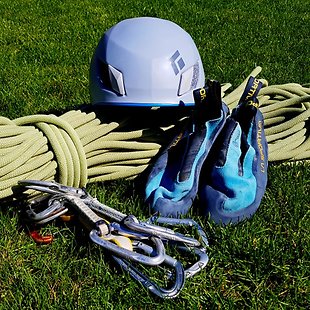Suspension syndrome
Whether performing high-altitude work or recreational and sport climbing activities, you may encounter the issue of suspension syndrome. It is a life-threatening situation characterized by syncope as a result of brain hypoperfusion, which can develop due to prolonged passive sitting in a harness. Resolving this algorithm, you will gain the knowledge of suspension syndrome prevention, which can be utilized by anyone in such a situation, as well as the knowledge of necessary steps in mountain rescue of two climbers, one conscious and one unconscious.
Review
Few professional rescuers in our country have come across a patient with suspension syndrome, previously called suspension trauma, during their practice. It is a condition that can easily lead to a patient’s death when the rescuers do not know the process of its development and basic principles of first aid. Due to the low frequency of these cases, disputable rescue methods were often described in the literature until recently. Thanks to the doctor Roger Mortimer‘s work in 2011, an international research of pathophysiology of this condition began and based on the results modern recommendations are presented, especially how to prevent the onset of this syndrome and what to do in case the syndrome has already developed. I appreciate that the website AKUTNĚ.CZ took the opportunity to pass on the knowledge of these current practices in an interesting way to professionals who, considering not only a massive increase in interest in sports like rock climbing, speleology or paragliding, but also high-altitude workers, who are being seen at work more often than before, may experience an accident complicated by a passive suspension in a harness more often.
Sources
LANFRANCONI, Francesca, FERRI, Alessandra, POLLASTRI, Luca, BARTESAGHI, Manuela, NOVARINA, Massimiliano, DE VITO, Giovanni, BERETTA, Egidio and TREMOLIZZO, Lucio, 2019. Impact of Hanging Motionless in Harness on Respiratory and Blood Pressure Reflex Modulation in Mountain Climbers. High Altitude Medicine & Biology [online]. 1 June 2019. Vol. 20, no. 2, p. 122–132. [Accessed 1 April 2020]. DOI 10.1089/ham.2018.0089. Available from: https://www.ncbi.nlm.nih.gov/pmc/articles/PMC6602116/
LANFRANCONI, Francesca, POLLASTRI, Luca, CORNA, Giovanni, BARTESAGHI, Manuela, NOVARINA, Massimiliano, FERRI, Alessandra and MISEROCCHI, Giuseppe Andrea, 2017. The Elusive Path of Brain Tissue Oxygenation and Cerebral Perfusion in Harness Hang Syncope in Mountain Climbers. High Altitude Medicine & Biology. 2017. Vol. 18, no. 4, p. 363–371. DOI 10.1089/ham.2017.0028.
LEE, Caroline and PORTER, Keith M, 2007. Suspension trauma. Emergency Medicine Journal : EMJ [online]. April 2007. Vol. 24, no. 4, p. 237–238. [Accessed 1 April 2020]. DOI 10.1136/emj.2007.046391. Available from: https://www.ncbi.nlm.nih.gov/pmc/articles/PMC2658225/
MORTIMER, Roger B., [no date]. Risks and Management of Prolonged Suspension in an Alpine Harness - Wilderness & Environmental Medicine. [online]. [Accessed 1 April 2020]. Available from: https://www.wemjournal.org/article/S1080-6032(10)00320-0/fulltext
PASQUIER, Mathieu, YERSIN, Bertrand, VALLOTTON, Laurent and CARRON, Pierre-Nicolas, 2011. Clinical Update: Suspension Trauma. Wilderness & Environmental Medicine [online]. 1 June 2011. Vol. 22, no. 2, p. 167–171. [Accessed 1 April 2020]. DOI 10.1016/j.wem.2010.12.006. Available from: https://www.wemjournal.org/article/S1080-6032(10)00402-3/abstract
RAUCH, Simon, SCHENK, K., STRAPAZZON, G., DAL CAPPELLO, T., GATTERER, H., PALMA, M., ERCKERT, M., OBERHUBER, L., BLIEMSRIEDER, B., BRUGGER, H. and PAAL, P., 2019. Suspension syndrome: a potentially fatal vagally mediated circulatory collapse—an experimental randomized crossover trial. European Journal of Applied Physiology [online]. 1 June 2019. Vol. 119, no. 6, p. 1353–1365. [Accessed 1 April 2020]. DOI 10.1007/s00421-019-04126-5. Available from: https://doi.org/10.1007/s00421-019-04126-5
RAUCH, Simon, SCHENK, Kai, GATTERER, Hannes, ERCKERT, Martin, OBERHUBER, Lukas, BLIEMSRIEDER, Bernhard, CAPPELLO, Tomas Dal, BRUGGER, Hermann, PAAL, Peter and STRAPAZZON, Giacomo, 2019. Venous Pooling in Suspension Syndrome Assessed with Ultrasound. Wilderness & Environmental Medicine [online]. 13 December 2019. Vol. 0, no. 0. [Accessed 1 April 2020]. DOI 10.1016/j.wem.2019.08.012. Available from: https://www.wemjournal.org/article/S1080-6032(19)30164-4
S, Leal, F, Becker, H, Nespoulet, P, Zellner and E, Cauchy, 2016. Proposal of an Effective Algorithm to Manage Suspension Trauma in the Field. Trauma & Acute Care [online]. 27 May 2016. Vol. 1, no. 2. [Accessed 1 April 2020]. Available from: https://trauma-acute-care.imedpub.com/abstract/proposal-of-an-effective-algorithm-to-manage-suspension-trauma-in-the-field-9385.html





